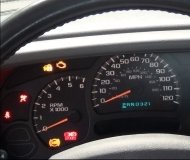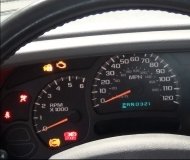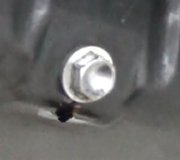P0121 - Throttle/Pedal Position Sensor/Switch A Circuit Range/Performance Problem
P0123 - Throttle/Pedal Position Sensor/Switch A Circuit High Input
P0174 - System too Lean (Bank 2)
P0340 - Camshaft Position Sensor Circuit Malfunction
P0405 - Exhaust Gas Recirculation Sensor A Circuit Low
First there are a couple of things to be aware of. When you disconnected the battery, the Engine Computer lost its memory. The fuel trim numbers will start to be rebuilt as you drive and you won't notice that, but the computer has to relearn "minimum throttle" before it will know when it must be in control of idle speed. Until that occurs, you may need to hold the accelerator pedal down 1/4" to get the engine to start and stay running, you won't get the nice idle flare-up to 1500 rpm at engine start-up, and it will tend to stall at stop signs. To meet the conditions for the relearn to take place, drive at highway speed with the engine warmed up, then coast for at least seven seconds without touching the pedals.
When you do that, the computer will memorize the voltage from the throttle position sensor. From then on, any time it sees that voltage, it will maintain the proper idle speed. No two throttle position sensors are ever alike. If the replacement reaches a lower voltage when the accelerator pedal is released, the computer will accept that new voltage as the signal to control idle speed. If the new sensor's lowest voltage is higher than the voltage it has in memory, it will always think you have your foot on the gas pedal and it will leave engine speed up to you. Stalling is likely to result.
As for the multiple codes, that typically occurs when there's a loose connector, stretched terminals that are not making a solid connection, or a wiring harness laying on a hot exhaust part or on a sharp edge of a metal bracket. If you have a scanner, you can view live data while driving the car and watch the throttle position sensor's voltage, but often intermittent dropouts will be detected by the computer, and it will set a code, but the readings on the scanner will update too slowly to see there. Most scanners have a record function that allows you to record a few seconds of data when the problem occurs. You can replay that recording slowly later to see if the voltage changed for an instant, but there has to be some symptom to tell you when to press the record button.
If that code comes back right away as soon as you erase it, there is a solid problem that will be easy to diagnose. Back-probe the three wires through the rubber seals to measure the three voltages. If you measure the middle one which is the signal wire, you must find approximately between 0.5 and 4.5 volts, depending on the throttle position. 0.5 volts will be found at idle / closed throttle, and there will be about 4.2 to 4.5 volts at wide-open-throttle. If the voltages are right on that signal wire, the other two have to be right too. One will have 5.0 volts and the ground wire will have 0.2 volts.
Monday, September 30th, 2013 AT 9:30 PM



